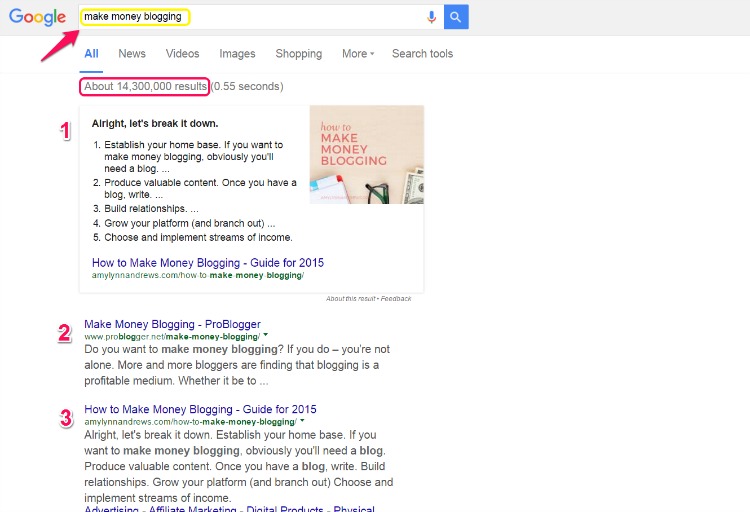Being productive when you don’t feel like it? Yeah, that’s tricky. You're not always going…

Build a Better Blog: Avoid Keyword Stuffing
Do you know what keyword stuffing is? No worries, if you don’t. Today’s post will explain what exactly that is and why you should stay away from cramming keywords in every nook and cranny of your content.
Before you go screaming wildly through the blogging hills, I know that keywords are not bad. In fact, putting keywords in your blog posts, videos, white papers, and other types of content can help them get found in online search results. But, when you overstuff your content with keywords, you will run into major problems.
Keep reading to learn what keywords are and why you should stay away from keyword stuffing. Hang around until the end of this post and you’ll get tips and suggestions for how to use them in your posts and website copy.
What is a Keyword?
Think of keywords as arrows that point people in your direction — people who are actually seeking out the services and products that you provide.
Keywords can be single words or even very specific phrases (i.e., long-tail keywords) that relate to particular topics. These are typically the words that you, me, and every other person on the planet types into a search engine to get more information.
For example, if you’re interested in learning how to monetize your blog, you might use the search phrase: “make money blogging” or “how to make money blogging.”

So, if you want to find apps to help your remote team work more effectively, make one slight adjustment to your search query and use “best collaboration apps remote teams” to refine your results.
Watch the video clips below to see how the SERPs (Search Engine Page Results) changed when the keyword phrase was adjusted to be more specific (click anywhere on each clip to begin playback).
This is likely the same process that your readers probably use when they conduct online searches. So, your job is to do a little keyword research to find the words or phrases that people tend to use to find the content or services you provide.
SERP #1: “best collaboration apps”
SERP #2: “best collaboration apps remote teams”
Keyword Stuffing: Avoid It Like The Plague
If keywords are so helpful, what’s wrong with using them a lot? Well, that’s a good question. The simple answer is that overstuffing your content is like cramming so much clothing in a drawer that it starts to crack or malfunction because it’s filled beyond it’s capacity.
That cracked drawer is like getting slapped by Google, though I’d say that getting banned by Google is probably worse. You don’t want that to happen to your website, right?
Keyword stuffing is considered to be an unethical search engine optimization (SEO) technique, which leads to banning a website from major search engines either temporarily or permanently. ~Wikipedia
And, just because you notice some sites using multiple instances of keywords — even if they sound unnatural and present a poor experience for readers — that doesn’t mean you should, too. Those websites are attempting to rank higher in search results by using a bad tactic.
Two words: no bueno. You know what happens to site visitors who have a negative experience with your website, right? They don’t come back. Ever.
So, be sure to avoid keyword stuffing and using underhanded (or black hat) practices. These tactics may be tempting, but using them will will ultimately result in a kick in the you-know-where, so why go down that road?
[ctt title=”Keyword Stuffing: Why You Should Avoid It Like the Plague” tweet=”Keyword Stuffing: Why You Should Avoid It Like the Plague http://ctt.ec/rdc1T+ via @DAllisonLee” coverup=”rdc1T”]
Hidden Keywords: Don’t Do It
There are other practices you should stay from, like using hidden text. Some websites have keywords in plain sight, so to speak.
They add multiple, irrelevant keywords to posts and web pages and hide them by changing the color of the text to match the background of the page (e.g., white text on a white background). The text won’t be visible to readers but will be to search engines. As you can guess, those search engines don’t like it very much.
I can’t say this enough — if you use these and other black hat practices, Google (and other search engines) will take notice and you will be penalized. I repeat: Using unethical SEO techniques will negatively impact your website’s ranking.
See Google’s Webmaster Guidelines for more information and have a look at this quick video to learn more about hidden text and keyword stuffing.
How to Use Keywords in Your Content
We’ve already established that keywords and keyword phrases can be pathways that lead readers and visitors to your content and website. And, we also know that we need to use them properly.
So, now what? You’ll probably want to do some keyword research before you begin creating your content. You can do this research after you write your post as well, and then optimize it based on your findings.
That said, when you write your blog posts or website copy, keep these tips in mind:
- Write for people. Write so that readers will understand your content (write for your readers, not for search engines).
- Keep it simple. Ensure that keywords sound natural (like when you’re speaking).
- Consider context. Use keywords that match the context of your post or website page (make sure they’re relevant).
- Connect to related content. Use keywords as links that redirect readers to other relevant and related content (these can be internal links, too).
- Add keywords to images. Use keywords to identify images in your content (alt tags).
- Add keywords to your title and headings. Add keywords to the title of your post and when possible, to the subheadings as well (remember, don’t overdo it).
Get More Information
Check out these posts to get more information about keywords and the best way use and optimize them. And, just in case you’ve already forgotten, stay away from keyword stuffing and hidden text.
- Irrelevant keywords
- SEO 101: The 5 Parts of Your Site You Should Keyword Optimize
- How to Use Keywords Throughout Your Marketing Strategy
- Blog Faster: How to Speed Up Your Research [Part 2]




Great advice! One of the things I like about the Yoast SEO plugin is that it will warn you if you’ve used your keyword too many times in the same page or post. It’s only happened to me once, but I was very glad for the heads up!
I love that feature, too! It does make you laser in on the focus of each post.
Very helpful, Deb. Alt text is so important for images. Some of my older images do not have the alt text so I am going back and added this information to them. Do you know of a plugin that can easily let you add the alt tag to images?
Hmmm … I’m not sure. I think you should be able to bulk select images in the WP media manager and add the alt tags that way. Let me know if that works, Sabrina.
Thanks for the instructional post. I believe I can learn from you.
Glad you found the post helpful, Maureen. =)
Still navigating the blogging “rules” – thanks for the advice.
There is a lot to keep in mind when you start blogging. Is there a particular rule or set of rules that are making you scratch your head, Elana?
So true, Deb! It’s horrible to read a keywords stuffed text and it can only hurt the site owner 😀
No disagreement from me! It makes for such a poor reader experience. Thanks for stopping by, Camilla. =)
Truly. You are writing for people, ultimately, and it is insulting to try to read a blog post that is nothing more than a jumble of words jammed in with no rhyme or reason. I exit and never head back. It’s hard work to create good content, no shortcuts to creating value for readers.
Agreed! If we focus on providing value, then we’ll never, ever cram keywords in blog post. Besides, it’s a waste of time. Nice connecting with you, Rosemond. =)